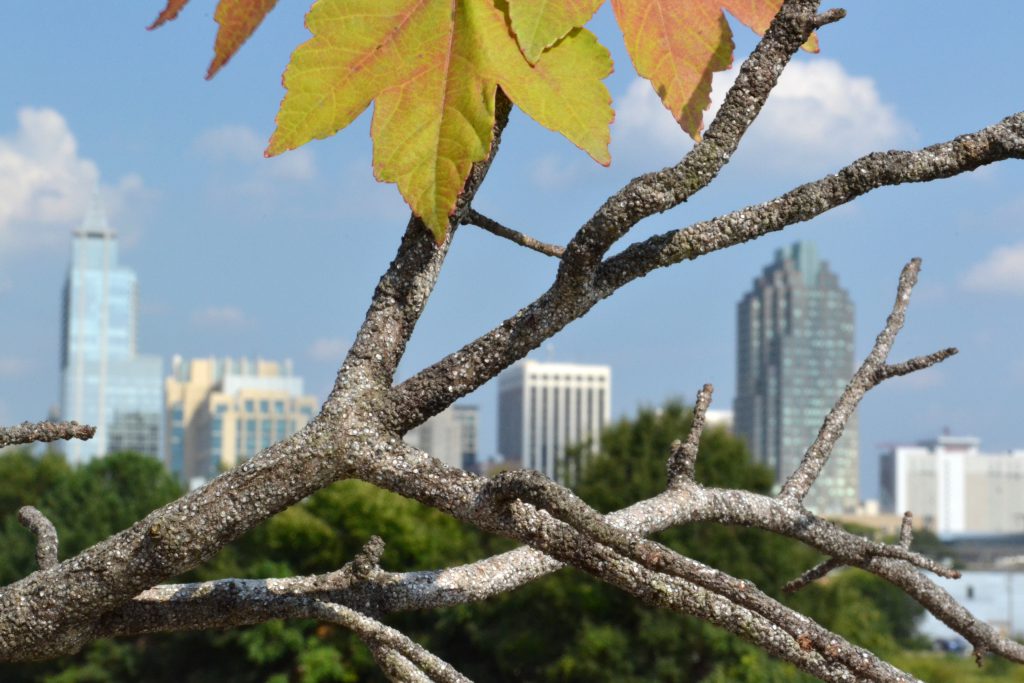Gloomy Scales in a Warmer Climate and How Cities Help Us Understand What’s to Come
Urbanization, climate change, and pests threaten North American forests. Urban trees have vast importance for the ecosystem services they provide to humans and other natural systems. Global Change Fellow, Adam Dale, and SE CSC Faculty Affiliate, Steve Frank, have been combing urban trees looking to understand the factors that influence the population growth of scale insects and what the implications might be for urban trees. The gloomy scale (Melanaspis tenebricosa), is an armored scale insect that feeds on vascular fluids from the trunk and branches of trees, primarily red maples. These herbivorous insects are drastically more abundant in cities than natural forests and feed on one of the most common landscape trees in the southeastern U.S.

They are great organisms for studying the impact of urban and global warming because they spend their entire 1-year life cycle in the same spot, exposed to the environment at their host tree. Just after being born, gloomy scale nymphs (called crawlers) actively walk around the tree to find a suitable place to settle down and feed for the remainder of its life (shown in the time-lapse video). Recent work by Adam Dale and Steve Frank shows that gloomy scale in warmer regions of the city produce 3 times as many crawlers per individual, than those on trees just 2 degrees Celsius cooler. This leads to a 200-fold increase in gloomy scale abundance, which combined with temperature, reduces the condition of red maple street trees. Another recent paper by Youngsteadt et al. shows that this temperature response found in cities is also found in natural forests. These results present serious implications for urban and natural forests as cities expand and the climate warms.
Control of this scale is complicated because crawlers emerge over 6-8 weeks so it is impossible to treat all the crawlers at once with horticultural oil or other contact insecticide. This is different than in other scales, such as euonymus scale, in which all crawlers are produced within a narrow window of 2 weeks or so. Adam Dale took a video of some gloomy scale crawlers so you can get an idea of how tiny and nondescript they are. This may also give you an idea of why scales are so vulnerable at this stage to the environment, predators, and insecticides like horticultural oil. Once they produce their thick waxy cover they are much less vulnerable to all these factors.
Here are three recent papers that highlight the above research. All three were funded, in part, by the SE Climate Science Center.
[button color=”#ececec” background=”#3a3a3a” size=”small” src=”https://secasc.ncsu.edu/wp-content/uploads/sites/178/DaleFrank_2014b.pdf”]Effects of Urban Warming on Herbivores [/button]
[button color=”#ececec” background=”#3a3a3a” size=”small” src=”https://secasc.ncsu.edu/wp-content/uploads/sites/178/youngsteadt-et-al_2014.pdf”]Urban Warming Trumps Natural Enemy Regulation [/button]
[button color=”#ececec” background=”#3a3a3a” size=”small” src=”https://secasc.ncsu.edu/wp-content/uploads/sites/178/DaleFrank_2014.pdf”]Do Cities Simulate Climate Change? [/button]
Time Lapse Video of Gloomy Scale Nymphs
Contributions to this post were made by Adam Dale and Steve Frank. Video credit: Adam Dale
- Categories:
